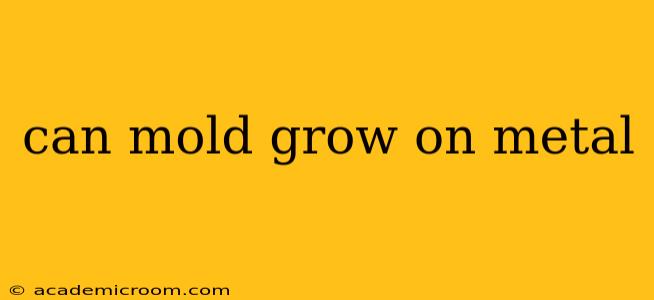Can Mold Grow on Metal? A Comprehensive Guide
Mold is a pervasive issue that can affect various surfaces in our homes and workplaces. While we often associate mold growth with porous materials like wood and drywall, the question of whether mold can grow on metal is surprisingly complex. The short answer is: yes, but under specific conditions. Metal itself is not a food source for mold, but various factors can create an environment where mold can thrive on or around metal surfaces.
This article will delve into the specifics, answering frequently asked questions and providing a comprehensive understanding of mold growth on metal.
What conditions allow mold to grow on metal?
Mold requires moisture, a food source, and the right temperature to grow. While metal itself isn't a food source, mold spores can land on metal surfaces and find sustenance in other materials present. This often occurs when:
- Moisture is present: Condensation, leaks, or spills can create the necessary moisture for mold growth. Think of a metal pipe that leaks, providing the perfect damp environment for mold to colonize nearby areas, even if it doesn't directly grow on the pipe itself.
- Organic matter is available: Dust, debris, food particles, or other organic materials accumulating on a metal surface can provide the nutrients mold needs to grow. A poorly cleaned metal countertop, for instance, can support mold growth if food residue is left behind.
- Temperature is suitable: Mold thrives in temperatures between 68°F and 86°F (20°C and 30°C). Metal surfaces, while not directly influencing temperature, can act as a substrate where temperature is suitable for mold growth.
Can mold grow directly on stainless steel?
Stainless steel, due to its non-porous nature, is less susceptible to mold growth compared to other materials. However, it's not entirely immune. Mold spores can settle on stainless steel surfaces, and if the above conditions (moisture and organic matter) are met, mold can still grow. Regular cleaning is crucial for preventing this.
What types of mold are most likely to grow on metal?
There is no specific type of mold that exclusively grows on metal. Any mold species capable of surviving in moist, nutrient-rich environments can potentially colonize a metal surface or the materials surrounding it. Common household molds like Cladosporium, Penicillium, and Aspergillus are all capable of growing near or on metal under the right circumstances.
How can I prevent mold growth on metal surfaces?
Prevention is key. Regular cleaning and maintenance can significantly reduce the risk of mold growth on metal:
- Clean regularly: Wipe down metal surfaces regularly with a mild detergent and water. Pay particular attention to areas prone to moisture accumulation.
- Address leaks promptly: Repair any leaks in pipes or fixtures immediately to eliminate sources of moisture.
- Improve ventilation: Ensure adequate ventilation in areas with metal surfaces to prevent moisture buildup.
- Control humidity: Maintain proper humidity levels in your home (ideally around 30-50%) to discourage mold growth.
Is mold growth on metal dangerous?
Mold growth, regardless of the surface it grows on, can pose health risks, particularly for individuals with allergies or respiratory problems. Exposure to mold spores can trigger allergic reactions, such as sneezing, coughing, and skin irritation. In some cases, it can lead to more serious health issues. If you suspect mold growth on or around metal surfaces, it's best to clean the area thoroughly or consult a professional mold remediation specialist.
By understanding the conditions that promote mold growth and implementing preventative measures, you can significantly reduce the risk of encountering this common household problem on metal surfaces. Remember, regular cleaning and prompt attention to moisture issues are crucial for maintaining a healthy environment.
